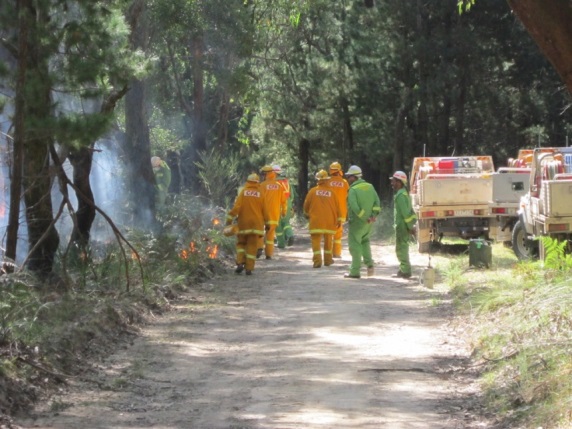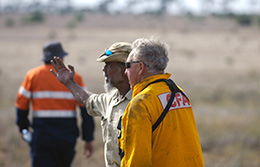CFA brigades conduct planned burning which reduce fuels to minimise the impact and spread of bushfire.
What is planned burning?
A planned burn is the controlled use of fire under carefully managed conditions to reduce fuel such as dead wood, leaf litter, bark and shrubs.
Why do planned burning?
Reduced fuel decreases the impact of bushfire by lowering the intensity of a bushfire. Low intensity makes it easier for fire-fighters to control a bushfire.
Fuel reduction is conducted at a board scale remote from settlements to reduce embers that on bad fire days start new fires some distance away from the main fire (up to 36 kilometres). This fuel reduction slows the rate of spread of a bushfire. It also increases the likelihood of suppression at the early stage of a bushfire.
Fuel reduction within 150 metres of a house significantly increases the likelihood of house survival by minimising the impact of radiant heat and ember attack.
Burning is also used by land managers to maintain the health of plants and ecosystems that need fire. For more information on fire and ecology read the topic Sustainable Fire Management.
Under severe bushfire conditions the effectiveness of planned burning reduces and the risk to life and property increases. Community members should prepare and maintain their property and manage vegetation to help reduce the risk around their homes and assets and act on their personal bushfire survival plan.
Who does planned burning?
Parks and reserves
Planned burning on protected public land including National Parks, State Parks and other crown land reserves is done by Forest Fire Management Victoria (FFMVic). For more information go to the FFMVic website.
Private land and other reserves
Planned burning is conducted by CFA brigades on behalf of and at the request of private land owners or managers of other reserves such as roads rail corridors, council reserves and water authority land.
Forest Fire Management Victoria (FFMVIC) and CFA fire-fighters routinely work together on planned burns.
How is planned burning done?
A planned burn is conducted under specified weather conditions by trained fire-fighters using specific lighting patterns and resources to meet burn objectives.

When is planned burning done?
Planned burning is undertaken when conditions are suitable such as mild and stable weather conditions. These conditions occur in a narrow weather windows throughout the year. A list of CFA and FFMVic planned burns and non-burn fuel treatments can be viewed as part of the Joint Fuel Management Program. The Joint Fuel Management Program can also be viewed as an interactive map.
Want to know more about planned burning in your area?
Parks and reserves
Information on planned burns conducted by Forest Fire Management Victoria can be found at the FFMVic website
Private land and other reserves
For more information about CFA burns in your area, please view the Joint Fuel Management Program map or contact your local CFA District Office. For information on private burn offs contact Triple Zero Victoria on 1800 668 511.
CFA planned burns can now be viewed on the FFMVic Statewide Outlook Map and on the VicEmergency website and app.
Planned burns notifications
CFA burns scheduled for delivery and underway can be viewed on the Planned Burns Victoria website. CFA planned burns underway can also be viewed on the VicEmergency website and app. Please register at Planned Burns Victoria to get notifications of upcoming burns.
Cultural Burning
Cultural burning, sometimes referred to as Traditional burning, is performed by Aboriginal people as part of their cultural responsibilities and obligations to care for country.
Cultural burning is the traditional ecological knowledge of Australia’s first people. CFA acknowledges all Victorian Aboriginal people as a cultural continuum. At CFA we acknowledge that fire is within the heart of all Aboriginal people and is what brings communities together.
In south eastern Australia the practice of cultural burning has been interrupted for more than 100 years. However, land and fire management agencies including CFA are doing what they can to support the restoration of the practice.
CFA recognises cultural burning can assist Victorian’s with the uncertainties of changing climate. Sharing knowledge will assist in developing adaptive fire management practices. This builds on supporting community through learning about how we live with fire.

For CFA this means working with three key principles
- Cultural burning is a practice performed by Aboriginal people for cultural purposes
- Cultural burning knowledge belongs to the Traditional knowledge holders.
- Cultural burning partnerships with CFA must be led by Aboriginal people.
Working together to foster knowledge sharing is an important way to enable participation of Aboriginal communities with CFA.
To find out more about how Victorians can support cultural burning refer to The Victorian Traditional Owner Cultural Fire Strategy
Page last updated: Tuesday, 11 November 2025 2:59:59 PM